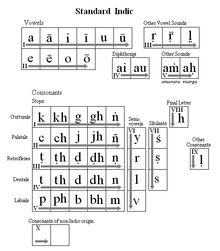- Dhives Akuru
-
Dhives Akuru Type Abugida Languages Divehi Parent systems Proto-Sinaitic alphabet- Phoenician alphabet
- Aramaic alphabet
- Brāhmī
- Southern branch
- Sinhala script
- Dhives Akuru
- Sinhala script
- Southern branch
- Brāhmī
- Aramaic alphabet
Child systems Dhives Akuru Unicode range not encoded yet Note: This page may contain IPA phonetic symbols. Main article: Dhivehi Writing SystemsSee also: Dhivehi language and History of the MaldivesDivehi Akuru or Dhives Akuru (island letters) is a script formerly used to write the Divehi language. This script was christened "Dives Akuru" by H. C. P. Bell who studied Maldive epigraphy when he retired from the British government service in Colombo and wrote an extensive monography on the archaeology, history and epigraphy of the Maldive islands.
The Divehi Akuru developed from the Grantha script. The early form of this script was Dīvī Grantha which was christened Evēla Akuru (ancient letters) by HCP Bell in order to distinguish it from the more recent variants of the same script. The ancient form (Evela) can be seen in the loamaafaanu (copper plates) of the 12th and 13th centuries and in inscriptions on coral stone (hirigaa) dating back from the Maldive Buddhist period. Like the native script of Sri Lanka and those of most of India, and unlike Thaana, Dhives akuru is descended ultimately from the Brahmi script and thus was written from left to right.
Divehi Akuru was still used in some atolls in the South Maldives as the main script until around 70 years ago. Since then, use is purely scholarly, or by hobbyists. It can still be found on gravestones, and some monuments, including the stone base of the pillars supporting the main structure of The ancient Friday Mosque in Malé. HCP Bell obtained an astrology book written in Divehi Akuru in Addu Atoll, in the south of Maldives, during one of his trips. This book is now kept in the National Archives of Sri Lanka in Colombo.
Bodufenvalhuge Sidi, an eminent Maldivian scholar, wrote a book called "Divehi Akuru" in 1959 prompted by then Prime Minister Ibrahim Nasir, in order to clarify HCP Bell's errors. However, Maldivian cultural associations have not paid much attention to Bodufenvalhuge Sidi's constructive work and keep perpetuating those errors.
Brāhmī The Brahmic script and its descendants Southern Brahmic
- Tamil Brahmi
- Tamil
- Pallava Grantha
- Kalinga
- Bhattiprolu Script
- Tai Le
- New Tai Lue
- Ahom
References
- Bell , H.C.P. Excerpta Maldiviana. Reprint 1922-1935 edn. New Delhi 1998.
- Bell , H.C.P. The Maldive islands. Monograph on the History, Archaeology and Epigraphy. Reprint 1940 edn. Male' 1986.
- Bodufenvahuge Sidi. Divehi Akuru; Evvana Bai. Male' 1958.
- Divehi Bahuge Qawaaaid. Vols 1 to 5. Ministry of Education. Male' 1978.
- Divehīnge Tarika. Divehīnge Bas. Divehibahāi Tārikhah Khidumaykurā Qaumī Majlis. Male’ 2000.
- Geiger, Wilhelm. Maldivian Linguistic Studies. Reprint 1919 edn. Novelty Press. Male’ 1986.
- Gunasena, Bandusekara. The Evolution of the Sinhalese Script. Godage Poth Mendura. Colombo 1999.
- Romero-Frias, Xavier. The Maldive Islanders, A Study of the Popular Culture of an Ancient Ocean Kingdom. Barcelona 1999.
- Sivaramamurti, C. Indian Epigraphy and South Indian Scripts. Bulletin of the Madras Government Museum. Chennai 1999.
- السّيّد ބޮޑު ފެންވަޅުގޭ ސީދީ. "ދިވެހި އަކުރު -- އެއްވަނަ ބައި." (Assidi Bodu Fenvalhugey Seedee. Dhivehi akuru—e`vana ba`i = Dhivehi akuru—volume one). Primary title(not representable in Unicode)
Categories:- Maldivian culture
- Brahmic scripts
- Phoenician alphabet
Wikimedia Foundation. 2010.


